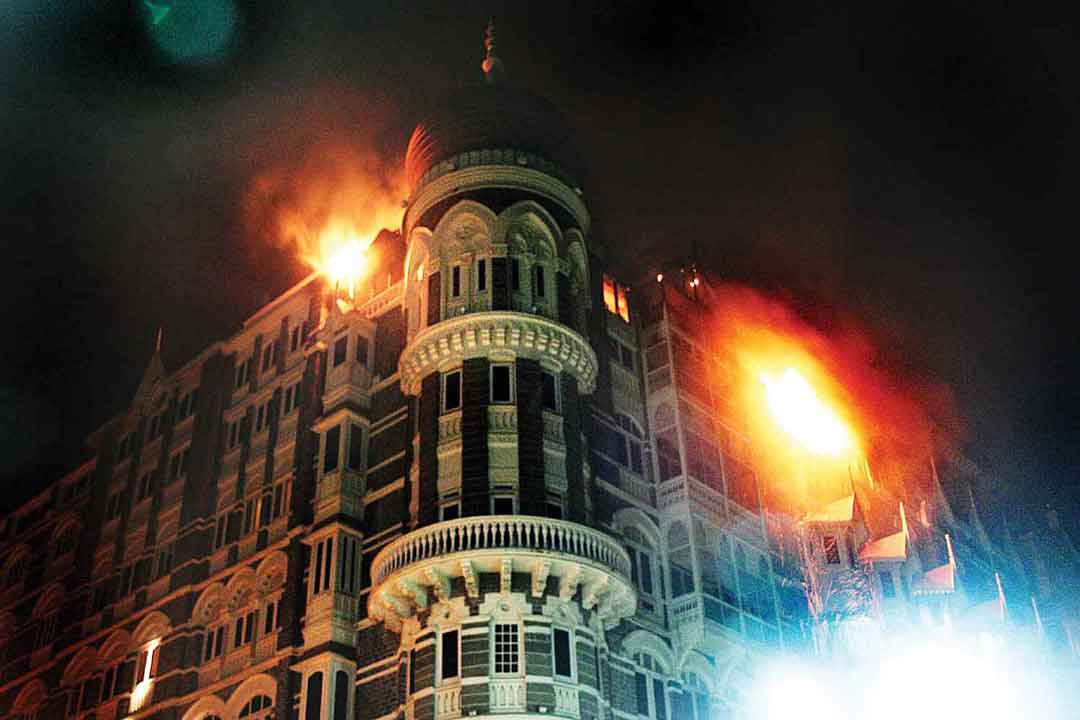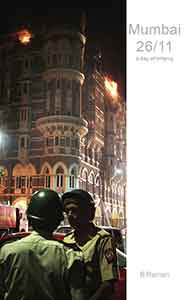
The heritage wing of the Taj Mahal Palace and Tower aflame, November 26. (Photograph: Uttam Ghosh/rediff.com)
It is five years since that dreadful night of November 26, 2008, which saw 10 terrorists making an amphibious landing onto the jetties of Mumbai, and proceeding to carry out sophisticated and simultaneous deadly attacks on multiple targets, including the city’s main railway station, two of its most prominent hotels, a popular outdoor cafe, a movie theater and a Jewish community center. These terrorists held virtually Mumbai, India’s financial capital of nearly 20 million people, under siege and indulged in mayhem. They killed brutally nearly 200 people.
…India is in a helpless and hopeless situation in punishing the real mastermind of the Mumbai-attack, LeT supremo Hafiz Saeed, the favourite of the Pakistani establishment.
As we remember that dreadful night, questions arise as to whether we have learnt any lessons and taken adequate remedial measures so as to prevent such recurring not only in Mumbai but also in other mega cities of the country. All told, the Mumbai-attack underlined one fundamental change in the nature and tactics of terrorist attacks. It was a departure from the common suicide bombings. Of course, the tactics adopted in Mumbai attacks were relatively simple, all known before -armed assaults, carjacking, drive-by shootings, building takeovers, barricade and hostage situations. They had actually ordinary weapons – assault rifles, pistols, hand grenades and simple improvised explosive devices. In fact, many experts said that the arsenal of the Mumbai-attackers resembled that of infantryman in 1940s. But, the newness lay in doing or putting all these things together in an impressively complex operation for which the attackers were systematically trained.
Secondly, and this is really significant, the Mumbai-attackers used well the 21st Century communications technology—cell phones, satellite phones, BlackBerrys, and GPS locators. Thirdly, they used soft targets – civilians – to have the maximum impact. They used civilians not only as hostages but also as shields to impede the counter attacks from the security forces and to maximise civilian casualties (increase the body counts, in the parlance of terrorism). These tactics were repeated successfully very recently in Nairobi Mall attacks (September). And in every likelihood, these will be repeated in future elsewhere, given the wide publicity and effect that this kind of attack in a prominent urban place by a motivated group prepared to give up their own lives generate. Fourthly, in what is called going for multiple targets, two of the Mumbai-attackers went to the city’s busiest railway station to open fire on commuters; the attack at the station alone accounted for more than a third of the total fatalities of the event. What this underscored was that terrorists now could view public surface transportation as a killing field.
Now coming to the lessons learnt, let us see what our government has done to prevent the recurring of another Mumbai-type attack. We have punished one guilty –Ajmal Kasab; he has been hanged. Our investigators have found out, along with investigating agencies of other countries such as the United States, that the attackers were Pakistanis. They were meticulously trained by the dreaded terrorist outfit Lashkar-e-Taiba (LeT), which, in turn, has close links with Al-Qaeda, the Taliban and other insurgent and terrorist groups find sanctuary in Pakistan’s turbulent tribal areas. In fact, it is an open secret that these groups have drawn on support from the Pakistan government itself, contrary to the latter’s denial. It is now universally accepted that the Pakistani Army, the most powerful institution of Pakistan, and its Inter Services Intelligence(ISI) uses terrorism as an instrument of the country’s foreign policy, confident that no country or force will dare to retaliate easily now that the country has nuclear weapons.
…local police must have the ability to act intelligently as the first responders. And there must be regular coordination among various intelligence agencies so as to preempt such attacks in the first place. But, are these happening?
What this means is that India is in a helpless and hopeless situation in punishing the real mastermind of the Mumbai-attack, LeT supremo Hafiz Saeed, the favourite of the Pakistani establishment. In fact, Hafiz is being treated like a “son-in-law” even by the present government led by Nawaz Sharif, his rhetoric about friendship with India notwithstanding. And India’s helplessness has been further compounded by the obsession of the Manmohan Singh government with the policy of unconditional talks with and unilateral concessions to Pakistan. So there is no question of Indian armed forces conducting an Abottabad –like operation (by the US Special Forces to nab and kill Osama bin Laden) to apprehend Hafiz from Lahore and put him under trail by our judiciary.
But what is more important, what has the government done at the domestic front to protect the “soft targets”, including hotels, shopping malls, and sports arenas? As is the case elsewhere, we need to have well trained and quick reaction security units (conspicuously absent during the Mumbai attacks) that can deal with emergency situations and ready to reach the trouble-spot at a very short notice. It is also obvious that local police must have the ability to act intelligently as the first responders. And there must be regular coordination among various intelligence agencies so as to preempt such attacks in the first place. But, are these happening? Besides, what improvements have taken place in the area of our coastal security, given the fact that the Mumbai attackers came in boats from Karachi undetected by our navy and Coastal security? Regrettably, the answers to these questions do not raise our comfort levels. The latest attempts at soft targets attending Narendra Modi’s public rally at Patna have reminded us the 26/11 horrors again.
Of course, over the last five years, the central government has established “the National Investigative Agency” (NIA), responsible for centrally investigating acts of terrorism and for processing intelligence and the creation of the Multi Agency Coordination Committee. But, two aspects have neutralised the intended advantages. One is that there have been no real intelligence reforms, so important for the success of the NIA. And that has been due to the tussle between the central government and the state governments over their respective prerogatives, with the latter arguing that under the country’s federal system the law and order are the “state subjects”. As Janani Krishnaswamy, in her “policy report” for “the Hindu Centre of Politics and Public Policy” (a sister organisation of the Hindu newspaper) rightly says, there are four categories of failure such as ‘intelligence failure’ or failure to produce accurate intelligence, ‘policy failure’ or failure to act on intelligence, ‘adaptation failure’ or failure to implement reforms, and ‘reform failure’ or failure to implement sensible reforms.
…the most notable bottleneck happens to be the politicisation of or the political pressure imposed on the police and intelligence agencies, thanks to vote-bank politics. We have seen in states like Bihar, Uttar Pradesh, Maharashtra and Kerala…
Here, and this my second point, the most notable bottleneck happens to be the politicisation of or the political pressure imposed on the police and intelligence agencies, thanks to vote-bank politics. We have seen how in states like Bihar, Uttar Pradesh, Maharashtra and Kerala, investigations of the crimes, not to talk of acting on the intelligence provided to preempt the crimes, have become community-sensitive and the governments of the day do not allow any police actions that adversely affect the traditional support-base of the ruling parties.
Similarly, in the area of coastal security Coastal Commands might have been set up under existing Naval Commanders-in-Chief who provide the necessary teeth to the legislation in as much as the maritime domain is concerned, but the gaps in the system are so apparent that one regularly comes across the incidents of foreign ships drifting and running aground on Indian shores undetected. As Vice Admiral (Retd.) Vijay Shankar points out, “Marine police units are in their infancy, and their ability to sprout ‘sea legs’ is tardy if not all together unworkable; while the coastline patrol force, the land element of the three dimensional interdiction plan, remains weedy in as much as its integration with the larger security scheme is concerned. In addition, tortuous command and control structures, poor coordination and dissemination of intelligence along with rudimentary standard operating procedures make for disjointed efforts. But the flaw lies in the fragmented demarcation of responsibilities between disparate forces controlled by State and Centre; in the absence of a coalescing doctrine the entire design appears to be, to say the least, fragile”.
It is sad indeed that even after five years of 26/11, and here again I quote Admiral Shankar, “no concrete measures are in place at sea, in our harbours and along the coastline that have either enhanced surveillance or brought hard intelligence to the man at sea or indeed, inspired confidence in those that stand watch. Initiatives that have been put in place are more tactical and those which have been enabled are through creativity and imagination in the field. Whilst planning and development may remain strategic we must not fall into the trap of preparing for a future even as we are rooted in an extremely precarious present. For after all security is, in the execution, a field function.”






Mr. Prakash Nanda is saying what is being said over and over again. The government at the state and the Center are unprepared to face another Mumbai massacre should it occur. Any serious planing is watered down by vested interests, infighting between law enforcement agencies and state fiefdoms. A unified force like FBI in US remains on the drawing board. The fact is that there is more than ample evidence linking terrorism in India to the Pakistani Military in power, yet our leaders are engaged in diplomatic talks with Pakistan giving them cover to continue to fund, train and expand Hafiz Saeed’s brigade. The next general election is the only opportunity for the citizens of India to stand up against Manmohan Singh government’s neglect of national security. Let us hope the change happens before Mubai2 happens.